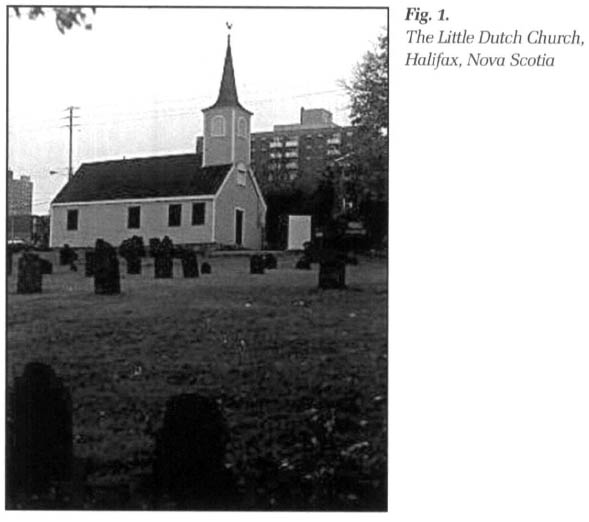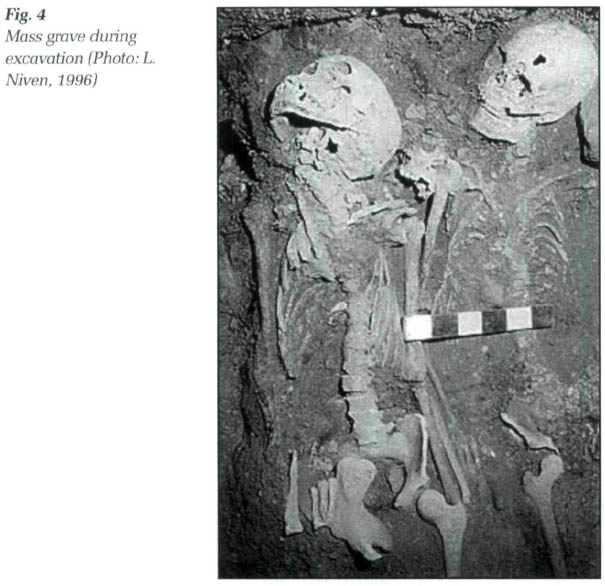Articles
Raising the Dead:
The Use of Osteo-Archaeology to Establish Identity at the Little Dutch Church, Halifax, Nova Scotia
Abstract
This paper looks at the role that the discovery of unknown human skeletal remains and their analysis plays in modern notions of identity and connection to place. This theme is prominent in a study of a mid-eighteenth-century mass grave discovered under the Little Dutch Church, Halifax. The church, built in 1756, is the oldest associated with German immigration and Lutheranism in Canada. In 1999, its role in the chronicle of German settlement was recognized in its commemoration as a National Historic Site. Recent state-driven heritage policies have employed sites such as the little Dutch Church to highlight the role of ethno-cultural communities in nation building and to qualify past "Anglo-French" national meta-narratives. However, such commemorations fail to acknowledge the numerous voices and corresponding silences that resonate in all sites. Multiple layers of meaning are often present, as is evident in an analysis of the occupants of the mass grave. This analysis has raised the potential for additional claims — notably Black and aboriginal North American — to the site's heritage.
Résumé
Cet article traite du rôle que la découverte de restes humains inconnus et leur analyse jouent dans les concepts modernes d'identité et d'appartenance à un lieu. Il s'agit d'un thème majeur de l'étude d'une fosse commune du milieu du XVIIIe siècle découverte sous la petite église hollandaise de Halifax. Construite en 1756, cette église est la plus ancienne à être associée à l'immigration allemande et au luthéranisme au Canada. En 1999, son rôle dans l'histoire de la colonie allemande a été reconnu par une cérémonie marquant son élévation au rang de site historique national. De récentes politiques gouvernementales en matière de patrimoine permettent d'utiliser des sites comme celui de la petite église hollandaise pour souligner le rôle des minorités ethnoculturelles dans la formation du peuple canadien et pour tempérer les vieux métarécits nationaux « anglo-français ». Mais de telles commémorations ne parviennent pas à témoigner des nombreuses voix et des silences correspondants qui résonnent dans tous les sites. Pusieurs strates de signification se superposent souvent, comme c'est le cas dans une analyse des occupants de la fosse commune. Cette analyse soulève la possibilité d'autres revendications patrimoniales de ce site, notamment de la part: des Noirs et des Autochtones de l'Amérique du Nord.
1 Buried in a shallow trench beneath the Little Dutch Church, in Halifax, Nova Scotia (Fig. 1), is a human skull, marked with symbols in red ochre, surrounded by sweetgrass, sage and tobacco, and wrapped in a red cloth. The whole lies bundled in a small, black, fabric, bag. A wire binds it shut. Attached to this is a thin copper tag, incised with the following:
Exhumed: 1998 from Unit 1J (extension)
Reburied: 25/08/1998 [Ind. E66a]1
2 But, in the anonymity of the laboratory code is hidden an individual with his own story and his own, given, name. These are now sadly lost in the past. Moreover, such a sterile representation belies a number of intriguing and intertwined narratives concerning the interaction of history, archaeology, forensic analysis, identity, and place, all of which may be understood in the story of an individual, "E66a."2
3 Corporeal remains are, arguably, the most profound elements of human material history. In a study of buildings, furniture, and clothing, material historians strive to find the people behind the things. Bones, skulls, and teeth, on the other hand, compel us to question life and human existence in general. Moreover, in human remains we find commonality. Death, after all, is one constant to which we all can relate. We cannot, therefore, undervalue the emotional attachment people have to human tones and to their burial sites. This relationship between the living and the dead has been recently explored by Sarah Tarlow in an analysis of changing burial customs in Orkney.3 Likewise, Katherine Verdery, in The Political Lives of Dead Bodies, explored the power of corporeal remains in helping to inform a sense of identity with place.4 While there is a simple human connection to burial places, to "dead spaces," there is also an understanding that human remains play important roles in creating or re-affirming identity to place. Often our interest in the dead, however, is centred on known individuals, those recorded in the pages of history or commemorated in a monumental epitaph. "The fact that the dead person is named and tied into other relationships," writes Tarlow, "gives the modern onlooker an empathetic emotional experience."5 Yet, as in the case of E66a, the majority of archaeological discoveries involve the bones of the unknown, those who history has forgotten or those whose deaths have gone unrecorded. Nevertheless, in some cases, their impact is significant.
4 Verdery makes the suggestion that the rewriting of history "may occur through the bones of the nameless."6 This was no more evident than in the forensic examination of E66a. His discovery, and that of a number of other skeletons, under the Little Dutch Church, set in motion a chain of enquiries. It prompted a re-evaluation of the historical narrative of the site and of its significance. Through the vehicle of the Little Dutch Church, this paper will address the following inter-related issues: the role that the discovery of human remains may perform in re-assessing the material history and sense of connection to place; and the part that osteo-archaeology plays in the process of "raising" the anonymous dead into a present consciousness, a process which may be viewed as both a physical and a metaphysical retrieval. Moreover, in the final analysis, we may also begin to raise a number of questions about how such discoveries and their subsequent analyses are used in projects of identity formation in place.
Raising the Dead
5 Of all relics of the human past, perhaps none are more moving, none more capable of inspiring emotion, of compelling us to consider our own mortality and to imagine our own ancestral pasts, than the bones of the dead. The unearthing of skeletons at tire African Burial Ground in Manhattan, for example, prompted one observer to comment:
6 Likewise, during the analysis of the 500-year-old iceman found on a British Columbia glacier in August 1999, it became apparent that there was an interest in his story that transcended scientific enquiry: "on one hand it's a study in science but on the other hand it's as if a person from the past is talking to me in a language I somewhat understand but I still don't understand all of it."8 A connectedness with the past fate of this individual is perhaps also indicated in the desire to name him, in the Southern Tutchone language, Kwaday Dan Sinchi, "Long Ago Person Found."9 Similarly, the recent discovery of the coffined remains of a child in London, Ontario, has excited much interest. While many Londoners entered into a debate about specific issues of identity and ancestral claims, there was also a sense of a common, popular, bond with the unknown child. One commentator was so moved to write:
7 Another remarked that here was "a nameless child, who although from the past, has touched the heart's of our entire community and gained an identity in the present."11
8 In such projects of identity reclamation, it is well to recognize that skeletal remains are the mortal remains of men, women, and children, who in life were loved, and in death, mourned;12 with whom many may still have a strong affinity (and indeed possible ancestry); and, in whom, some choose to associate ideas of cultural legitimation. Verdery terms the symbolic/political relationship between the living and the remains of the dead, "dead body politics." In this sense, such remains and the places of their burial, or reburial, become not only potential loci of remembrance and meaning, but also sites in which the potent relationship between kinship, identity, and soil are fixed. This process of localizing the dead, Verdery suggests, "sacralizes and nationalizes spaces as 'ours,' binding people to their national territories in an orderly universe."13
9 In this process, the appeal of bones is reinforced by their corporeality. That they represent a real, or tangible, "past,"as opposed to an historical abstraction, causes an underlying world to be made visible and accessible: "An echo from the remote past, suddenly become[s] present and actual.14 "Jean-Claude Schmitt contends that "the dead have no existence other than that which the living imagine for them.15" But, "the dead are everywhere," writes Michael Parker Pearson, "inhabiting our memories and forming our world." He adds:
10 The corporeality of human remains help us to forge powerful links between the living and the dead, between an often uncertain present and an idealized past, in what Barbara Bender has coined, a "choreography of death.17" Even the ancient dead are very much with us, Pearson argues, "tied to the living through political, religious, economic, social and ancestral links.18" Anne-Marie Cantwell furthers this argument, suggesting that,
11 "In divided communities," she adds, "in troubled times, living peoples may reach back into the past and join with the dead in creating an 'imagined community' that mirrors their vision of the world in which they wish to live."20 However, the interpretation of, and the subsequent significance attached to human bones reflects the inclinations or attitudes of the society or culture in that particular time and place. Further, different individuals or groups within society may not only choose to "read" the bones in very different ways but they may then choose how those bones will be (re)written into the history of a place. Thus, while concrete, human remains are simultaneously ambiguous, polysemic, protean, without a single meaning but capable of being read in many different ways and of evoking "a variety of understandings."21
The Dutch Church, Halifax
12 The story of E66a is part of a complex burial narrative that has its beginnings in the mid-eighteenth history. The story has been brought back into present consciousness through archaeological excavations in 1996 and 1998 that exposed a previously unrecorded mass grave beneath the Little Dutch Church (Fig. 2).22 However, the significance of this finding must be evaluated not simply in terms of our continuing understanding of the historical narrative of the church, but also as it has played itself out within broader issues of identity with, and construction of place, and claims of a "national" heritage. In this construction, several events play key roles that will be touched upon below: the forensic analyses of the bones from the church; the perception of the information from that analysis; the related "Service of Reburial" in 1998; and, the commemoration of the church as a National Historic Site in 1999.
13 The Dutch Church is associated historically with German speaking ("Deutsche") settlers, mostly drawn from the Palatinates, who settled in the North Suburbs of Halifax between 1750 and 1752. Perhaps as early as 1750, the present site of the church was allotted to this Lutheran community, for burial and for the erection of a meeting house (Fig. 3)23 On the evidence of the grave beneath the church, it would appear that burial had begun prior to the construction of the church in 1756. The church, the oldest associated with Lutheranism in Canada, was used regularly until 1800, at which time a growing congregation necessitated the construction of a new church, St George's, the "Round Church," a block to the south. Burial continued in the churchyard until the mid-nineteenth century when urban pressures and public health concerns forced its closure. Over the next 150 years, the church saw infrequent use, although it remained an important landmark within the Parish of St George.
14 In 1994, the Dutch Church was pressed back into regular service after fire heavily damaged the parish church. Renewed use exposed structural problems in the foundation walls. The subsequent restoration project attracted the attention of the Province of Nova Scotia, and, in 1996, a small team of archaeologists under the direction of Laird Niven and myself was called in to assess the potential archaeological resources under the church. The goals of this investigation included: the location of hitherto un-recorded archaeological remains; the exposure of the foundation walls in selected areas; and the confirmation of a previous discovery of bones beneath the church in December 1896. In the latter instance, human bones were discovered by workmen during the construction of a new foundation wall. The discovery was described in the Acadian Recorder.
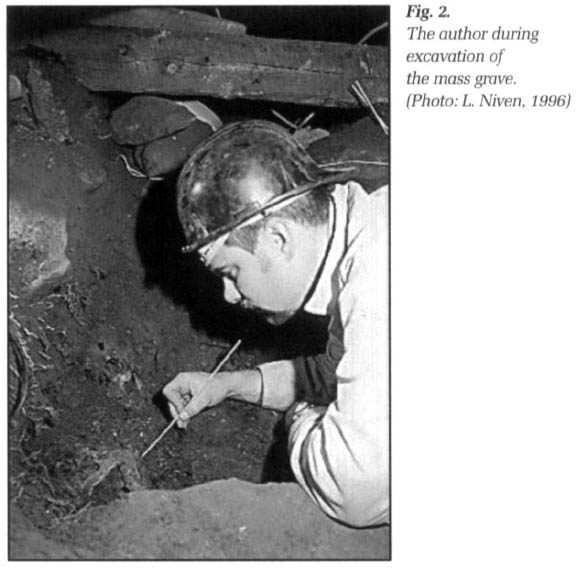 Display large image of Figure 2
Display large image of Figure 2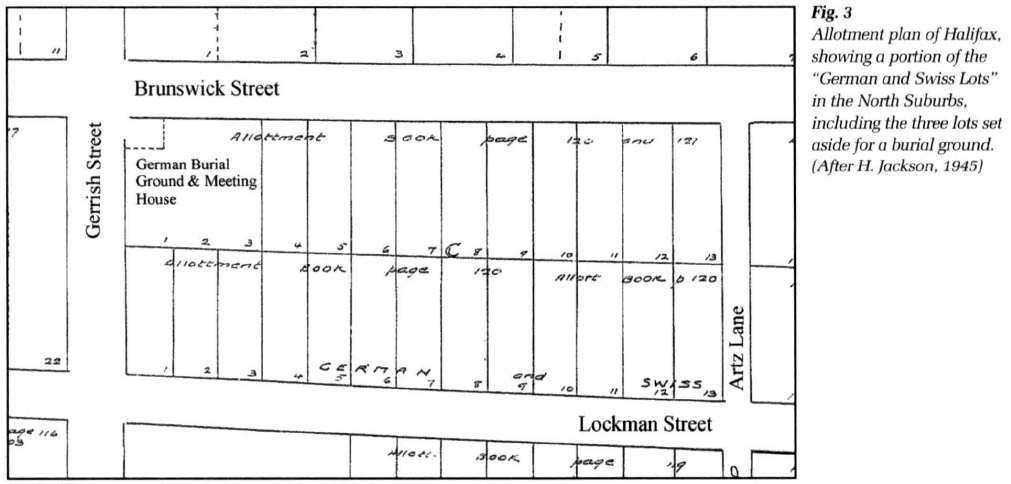 Display large image of Figure 3
Display large image of Figure 315 In May 1996, the need to establish the condition of the foundation walls and to assess the veracity of the 1896 reports prompted excavation beneath the church. Three test pits were opened. In two, articulated human skeletons were soon encountered as little as 0.3 metres below the surface (Fig. 4). By the end of the season seven skeletons had been exposed, layered two deep, and head to toe in one test-pit. A further three were encountered in the second test pit; the truncation of some by previous trenching suggesting that these were undisturbed portions of the bodies which had been discovered in 1896.
16 Extreme working conditions and the complex nature of the burial slowed progress, and coupled with financial constraints, left the investigations uncompleted in 1996. The test areas were backfilled and the bones of six individuals, along with three skeletons from three later eighteenth-century crypts, were removed to Saint Mary's University for analysis and safekeeping. In 1998, following the establishment of a new concrete foundation for the church, investigations continued in the earlier test areas to complete the previous work and to find suitable locations for the reburial of all the bones. In the process, the 1896 reburial pit was located and the partial remains of thirteen individuals were excavated. Further, those skeletons that had been left in situ were removed, allowing the depth and nature of the burial area to be determined.
17 The depth of the burial trench varied between 1 and 0.5 metres in an easterly direction, corresponding with the slope of the original ground surface, and was approximately 3 metres in width. The western edge of the trench was delineated by the western foundation wall while the eastern edge fell along the centre line of the undercroft. On the basis of limited testing, the length of the trench could not be ascertained. Its northernmost extent, however, appeared to terminate at an earlier (i.e., 1756) foundation wall that had marked the northern extent of the building prior to the addition of its steeple in 1760.
18 Each of the bodies was placed in an extended prone position. In at least one instance, the arms were folded across the chest and the feet were crossed. In other cases, it was apparent that burial had been hasty and carried out without much care. During the process, large rocks were placed over some of the bodies. Further, the whole trench seemed to be capped with a layer of rocks. The purpose of this is unclear although it was perhaps intended to prevent disturbance by animals. No evidence of coffins was found. Likewise, with the exception of two plain, two-holed, leather buttons and a small oblong piece of corroded iron that may have been a buckle, no indications of clothing was recovered. Dark brown, organic staining found around many of the skeletons may have been the remains of clothing or the sacking in which individuals were likely buried. Personal effects, or other artifacts which would have given an indication of date of burial or the identity of the occupants of the grave, were absent. Well preserved rope samples were, however, retrieved from above the skull of one of the undisturbed skeletons, suggesting that at least one of the individuals had been tied into a shroud or sacking.
 Display large image of Figure 5
Display large image of Figure 519 The arrangement of the grave, bounded on the north and west by the foundations of the church, gives every indication that the building may have been later purposefully erected above the grave, perhaps as an act of piety. From the outset, it was clear that this was a mass grave. Burial in large mass graves, fosse communes, had been commonplace in Europe from the later medieval period (Fig. 5).25 Often associated with the poor or with burial in times of epidemic, a fosse could measure several metres in length and breath and be as much as six metres deep. Many hundred corpses were lowered into such pits, seldom in coffins, but sewn or tied into shrouds or winding sheets, and layered, perhaps unceremoniously, many deep and often head-to-toe. This pattern would continue until the trench was filled, perhaps in a scene reminiscent of that fictitiously described by Thomas Raddall for the burial ground of Saint Paul's Anglican Church, Halifax:
Identifying the Dead
20 No historical documentation has yet been found for the presence of mass burial on the site of the Dutch Church. Burial records for the churchyard do not begin until the 1760s and early documentation in general is slight. Mass death is known to have occurred in the early years of the Halifax colony, and, between September 1749 and April 1750 alone, the deaths of 237 persons were recorded (Fig. 6). Of these, 172 were civilians and 65 were soldiers or mariners. Alan Marble writes that, "the mortality rate among the civilian population was, therefore, approximately nine percent during the seven-month period."27 While this number was significant, reports of a major epidemic resulting in 1000 deaths, as reported by T. B. Akins, seem to have been grossly exaggerated.28 Nevertheless, the death toll was such that Governor Edward Cornwallis was prompted to have a hospital constructed in the early part of 1750. This was the situation into which emigrants in 1750 were introduced.
21 Other epidemics were to affect the colony in 1755-6, 1757 and 1775-6.29 For our purposes, however, the events surrounding the arrival of emigrant ships from Europe carrying "foreign Protestant "settlers — Germans, Swiss, French, Palatines — between 1750 and 1752, may hold the best clues as to the identities of the occupants of the mass grave. In the late summer of 1750, 795 "foreign Protestants" landed in Halifax.30 While the passengers on two of the ships, the Alderney (23 August) and the Nancy (16 September), were in good health upon their arrival, those on the Ann (2 September) were described as "very sickly and many dead."31 Unfortunately, we have no details of the nature of the illness aboard the Ann.
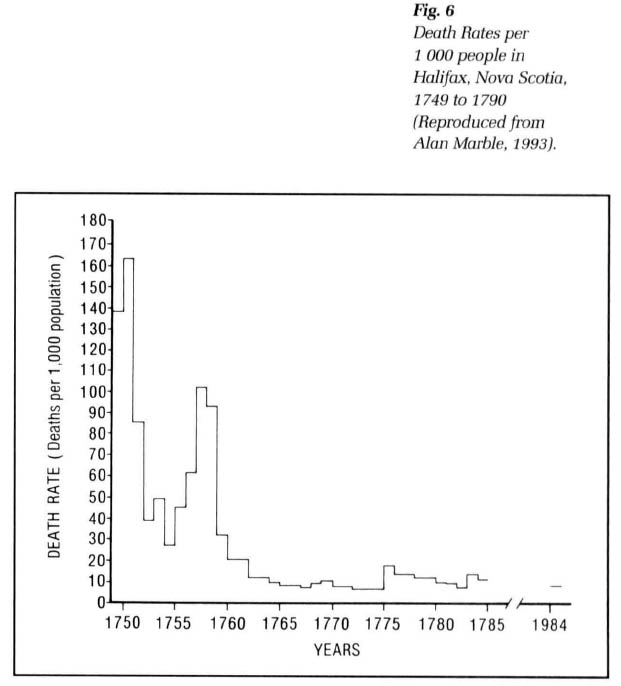 Display large image of Figure 6
Display large image of Figure 6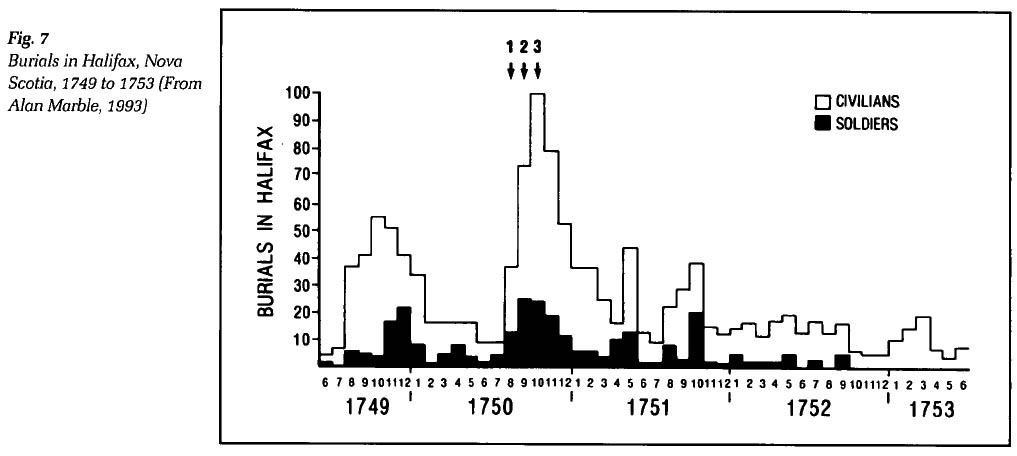 Display large image of Figure 7
Display large image of Figure 722 That the health of the community as a whole began to deteriorate in the months following the arrival of the Ann is apparent from the sudden increase in the number of burials in the late summer and early fall of 1750 (Fig. 7). By early October, the situation was seen to be bad enough for Cornwallis to order the removal of the sick to "the house of Major Lockman where there are chimneys and the persons that are in health that are there, to be removed to the place where the sick now are."32 In his instructions to Lockman, Cornwallis wrote, "You are hereby directed to make such a disposition to them if it appears to you to be necessary for their comfort and to hire such of the persons in health among them to attend the sick as may be necessary, promising them a reasonable allowance for their service."33 John Salusbury's diary entry for 16 November 1750 further highlights the prevailing health conditions: "it is hoped that the weather will clear the air and make the settlement more healthy. We have had more sickness this fall than last."34 This was later confirmed by the Boston Gazette on December 11, which commented that, "the people are very sickly especially the meaner sort, and the Germans, which is probably owing to change of climate, want of necessaries, and bad attendance."
23 Alan Marble's analysis of the burial records from St Paul's Anglican Church for an eight month period between August 1750 and March 1751 reveals that, "a total of 333 persons, an average of forty-two per month, had died." This may be contrasted with the succeeding twenty-seven month span in which the average mortality dropped to only twelve per month. In 1751, no further disease was detected on incoming immigrant ships. The general good health of the settlement was later confirmed by the Boston Gazette on 27 August 1751. While illness again plagued some of the emigrant ships in 1752, more lengthy quarantining appears to have prevented further wide-scale deaths.35
24 Of the high mortality in the late summer, fall, and winter of 1750-1, Marble has concluded that, "it would appear that some form of epidemic ravaged the population."36 While no primary records exist concerning the details of such an epidemic, it was likely to have been brought about by a fast-acting and virulent form of typhus fever, petechialis. Spread by body lice, it is still endemic in Africa, Asia, and Central and South America today. Along with smallpox, it was the most likely cause of epidemic death in eighteenth-century Europe.37 It spread rapidly in unhygienic, overcrowded conditions such as were found in hospitals, jails, military encampments, and passenger ships.38 Typhus was particularly prevalent in the later summer and fall.
25 The St Paul's burial records between September 1750 and July 1751, show that 59 settlers who arrived on the Ann in September 1750 died during that period.39 It is almost certain that they would have been buried in the Dutch burying ground as many of them had settled on the German and Swiss lots in the vicinity of the church.40 Limited transportation and the fear of Indian attacks would have prevented the movement of the dead any great distance. Proximity to the churchyard was, therefore, important. More so, as at this time the only other official burial ground was located south of the town. Burial circumstances at that time are unclear, but it is likely that the dead would have simply been buried in a mass grave, in accordance with established practices in times of epidemic. During such times, fear of contagion would have prompted immediate and hasty burial wherever necessary. The dead would have simply been buried beyond the palisades, in a forest clearing, in a shallow trench. Nor would there have been much in the way of social, cultural, or religious discrimination during burial.
Reading the Osteo-Archive
26 By the end of the excavations in 1998, the bones of an estimated thirty individuals had been recovered from under the Little Dutch Church. The osteo-archive included the remains of the individuals removed from the three crypts; nine complete skeletons, excavated from the mass grave; and the partial remains of twenty-one others. In the latter instance, the remains of thirteen individuals consisting of 610 commingled bones and bone fragments were recovered from the 1896 reburial pit. It is unclear at this stage how many bodies remain unearthed. A preliminary estimate suggested, rather tentatively, that between eighty and one hundred individuals may have been buried in this space.
27 Using a range of standardized biometrical tests, Dr Paul Erickson and Nicole Lundrigan of Saint Mary's University in Halifax determined that the bones recovered at the Little Dutch Church represented a burial population of mixed gender and age.41 The age of the majority of the individuals appears to have fallen between twenty-eight and thirty-eight years. Only three individuals were believed to be under the age of eighteen and one was calculated to be approximately sixty years of age. The group, as a whole, had generally been robust and in good overall health prior to death. No signs of trauma or pathological markers were present in the bones. This suggested that the cause of death was likely a fast-acting and virulent infection, affecting the soft tissue, but which did not leave any telltale traces in the bones themselves.
28 As to their ethnic origin, the 1896 report had claimed with certain conviction that skulls of the original German settlers in Halifax had been "EXPOSED TO VIEW," an interpretation based on what the reporter concluded to be "historical fact. "42 In making such claims, inference was naturally drawn from the location of the bones beneath a church associated with those settlers. No further analysis took place. In 1996, biometrical testing of the newly discovered remains seemed to confirm the European hypothesis (although ethnicity could not be ascertained). However, in 1998, measurements from fourteen specimens were entered into a comparative forensic database.43 The results were surprising: analysis revealed that in seven cases the most probable racial categorization was "Black;" in six, "White;" and in one, "Amerindian."44
29 While the statistical probabilities were not always strong, the results were felt sufficient to challenge earlier analytical assumptions that this was an exclusively European burial site. Instead, a picture began to be formed of a mixed racial burial that included individuals of African and aboriginal North American origin. Interest, therefore, has focused on the eight apparently non-White specimens. In particular, much of the attention has been directed at E66a. Unfortunately, the partial crania was the only recognizable portion of this individual. Moreover, there was post-mortem loss of the occipital bone, zygomas, and mandible. While not conclusive, biometrics demonstrated that this individual was likely a male in his late twenties or early thirties.45 Morphologically, he was distinctive from others in the burial sample.46 He had broader facial features, a sloping forehead with a pronounced supra-orbital ridge, and enlarged orbits and nasal cavity. Further, he exhibited a degree of alveolar prognathism, slight shovelling of the incisors, and moderate to severe occlusal attrition. To a degree, the latter are characteristics more commonly associated with someone of aboriginal North American rather than of central-European or African origin.47 Both a standard biometrical examination and the processing of data through the analytical forensic database, however, failed to produce conclusive results. Nevertheless, it was generally felt that this individual could not be excluded as aboriginal North American.48
30 Despite the lack of statistical certainty, additional evidence supports the notion that E66a. and conceivably others, does not fit the European profile. Attention was specifically drawn to the degree and kind of dental attrition found in E66a (Fig, 8). The flat occlusal wear of both anterior and posterior teeth and the exposure of the pulp cavities, in a person whose estimated age was in his late twenties or early thirties, is more consistent with someone of North American aboriginal origin than someone of European extraction. Erickson argues that, "attrition of this sort has been observed on American aboriginal skeletons, especially those from the American Southwest, and has been attributed to a traditional diet with a high component of hard morsels and grit."49 Long-term, consistent, occupational use of the teeth, the working of hides and sinews, for example, produces similar results, as is evident in many older Inuit.
31 Micro-wear analysis of the occlusal surfaces also appears to support the evidence of a hard impact diet for E66a.50 In such an analysis, particulates in the diet leave telltale signs, such as scratching, pitting, and scarring on the teeth, which are only detectable through scanning-electron microscopy. Fine scratching is more apparent in refined technologically processed diets as found in agricultural populations. Contrastingly, hunter-gatherer diets that consist of gritty hard impact food items such as dried meats, bones, and seeds, can result in pitting or deep scarring. In such diets, the acidity of certain vegetables and fruits may result in the removal of finer scratching. Analysis of E66a showed that no microwear scratches were present but that there was a high incidence of microwear pits. Only one other specimen, E31, showed similar wear patterns.
32 How strong a case may be made for a statement about the ancestry of E66a is still being debated. Despite the lack of conclusive data, questions began to be asked within the research team about the analytical bias that had assumed the ancestry of those buried beneath the church to be European.51 Concern was also voiced about the value of methodological constructions of race, based on cranial morphology or biometrics.52 The weight of historical association and the physical context had pointed clearly to the latter interpretation of all the skeletal material. The discovery of E66a challenges the previous notions. Consequently, analysis has now shifted from a singular search for hard scientific certainty towards a parallel study of historical potential — especially the potential for the burial of aboriginal North Americans and, even, Africans in such a mass grave.
Who Was E66a?
33 But, who was E66a and what was he doing buried in this mass grave, in a settler cemetery, on the outskirts of an English settlement? Was he Mi'kmaq? Was he Protestant? The answers, as of yet, are not forthcoming, however, historical indications might suggest that he was not Mi'kmaq. The latter were historically allied to the French and, more so, had largely converted to Roman Catholicism. On the other hand, relationships with the Native peoples were complicated. Among the early colonial records are references to Mi'kmaq raids on Halifax and Dartmouth, to treaties signed with "friendly Indians," and to the controversial Goreham's Rangers.53 The latter, mainly Mohawks and persons of mixed race from the American colonies, were brought to Halifax in 1749 to counter the purported Mi'kmaq raiding.54 Little is written about this Mohawk, or indeed any Native presence, in Halifax, but it raises intriguing questions. Perhaps the most interesting is a reference to the burial of a John Tray, "Protestant Indian," in the St Paul's burial register for 27 August 1750.55
34 While much of the analytical attention has focused on E66a, the potential for an African presence in the burial sample is equally intriguing. Sadly, much of the earliest Black history of Nova Scotia has yet to be told. Regardless, Bruce Fergusson estimated that, prior to Loyalist Black immigration, there were perhaps as many as five hundred slaves in the province.56 Most served as domestics in the employ of British and New England colonists, but some were also involved in the construction of Halifax. When their services were no longer needed they were sold on. In September 1751, the Boston Evening Post, for example, announced: "Just arrived from Halifax and to be sold, ten strong, hearty Negro men, mostly tradesmen, such as caulkers, carpenters, sailmakers and ropemakers..." Fergusson notes that among those victualled in Halifax in May and June 1750 were at least fifteen slaves.57 That there were also "free Blacks" in Halifax is evident in the 1752 victualling lists where, "Peter, a Negro" is recorded as a head of a family.58
35 It is also likely that prominent members of the German community owned slaves. Among the household of Major Leonard Lockman, a German surgeon, were listed seven "servants." Their racial origin is unknown, but that Lockman had a tacit connection with slavery is evident in an advertisement in the Halifax Gazette, 15 May 1752, which announced: "Just imported, and to be sold by Joshua Mauger, at Major Lockman's store in Halifax, several Negro slaves." A slave is also known to have been listed in the Schwartz household, and, later, we find reference to the fact that Rev. Bernard Michael Houseal, first full-time minister to the German community in the latter part of the eighteenth century, had slaves of his own.59
36 Despite such historical inferences, no firm answers have yet been found as to the identity of the Little Dutch Church skeletons. All that may be said with certainty is the following: this was a pre-1756 mass grave; it was located in a German-Lutheran burial ground; it definitely contained the remains of Europeans; it likely contained at least one aboriginal North American; and it may have included individuals of African descent. It is unclear whether a clear sense of historical identity may ever be achieved. Genetic testing of bone samples may help to shore up the lack of historical confirmation and further corroborate the gross forensic analysis, but this remains to be completed. Nevertheless, the implications of the findings thus far are profound.
Reburial and Commemoration
37 On 25 August 1998, all of the human remains were returned to the church "undercroft." This brought to a close the archaeological and forensic studies. It also fulfilled a promise made to the Parish of St George that all of the bones would be returned to the church following the restoration of the building. The excavations of 1998 established "safe" places for reburial, eliminating any impact on, or confusion with, in situ skeletons. All the remains had been "bundled," the nature of the reburial preventing any realistic repositioning of the articulated skeletons in their original "prone" attitudes. Furthermore, the original burial location of both the loose bones and those retrieved from the 1896 reburial pit could not be re-established with any certainty.
38 The "service of recommittal," brought together various players: the archaeologists; officials and parishioners from the Parish of St George; descendants of the German settlers; members of the German Canadian Association of Nova Scotia; a small delegation of Mi'kmaq spiritual leaders; and, the media. It included eighteenth-century burial rites, German hymns, and a Mi'kmaq sweetgrass ceremony (Fig. 9). The blending of spiritual traditions proved strangely appropriate; the incantation of the Mi'kmaq "Sacred Seven Prayer," complementing the simplicity of the Anglican burial rites. Throughout, the smell of burning sweetgrass filled the church. A quiet dignity marked the proceedings. This was marred only by the glare of the media lights.
39 The service concluded with the lowering of the bones into the space beneath the church. All bones, including those of E66a, were returned once again to a common grave. Prior to the service, each set of bones had been placed into black fabric sacks.60 The only indication of the events that had unfolded in 1996 and 1998 were the copper tags, attached to the wire closures. These tags were not simply taxonomic indicators but were now intended to act as mnemonic devices, conveying information into the future. Apart from a laboratory code, there was no sense of individual identity, no names, no indication of ethnicity. However, in preparing the skull of E66a with the trappings of Mi'kmaq ritual — the application of red ochre symbols on the forehead, the wrapping of the skull in red flannel, sweetgrass, tobacco, and other herbs, the ritual purification with smoke from burning sweetgrass — he was clearly distinguished from the others. In that process, both E66a and the Little Dutch Church were adopted into a Mi'kmaq sacred world, this despite the lack of scientific certainty as to his specific tribal identity.
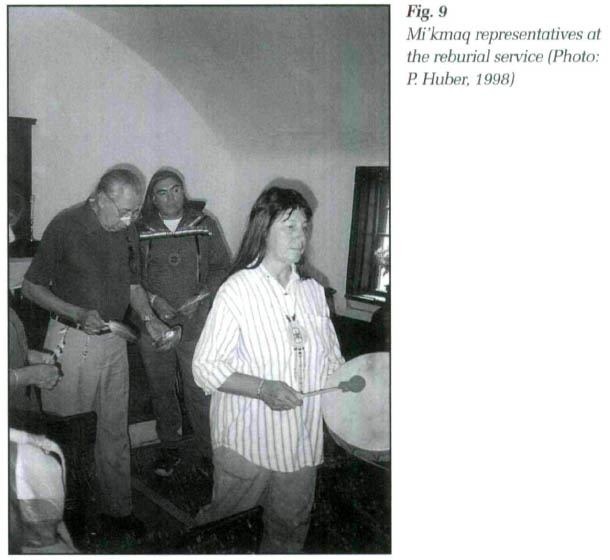 Display large image of Figure 9
Display large image of Figure 940 But, the significance of the Little Dutch may also be viewed beyond more localized issues of identity. In addition, it has been recognized on a larger political stage. On 26 August 1999, it was commemorated by the Historic Sites and Monuments Board of Canada as a National Historic Site. The ceremony was held under blue skies in the churchyard, before an audience of invited guests including the Lieutenant Governor of Nova Scotia; representatives of all levels of government; delegates from the Parish of St George, the Anglican Diocese of Nova Scotia, and the Evangelical Lutheran Church of Canada; and, members of the German Canadian Association of Nova Scot in. Significantly absent were representatives from the First Nations and Afro-Canadian communities. Obligatory speeches were interspersed with the singing of the National Anthem and "Eine feste Burg," and with the unveiling of the National Historic Site plaque (Fig. 10). At that moment, "official" history endorsed the role of the Little Dutch Church in the chronicle of German settlement in Nova Scotia and in the meta-narrative of the nation. A version of history was formalized, given authority, and, through the ritual act of commemoration, placed into the myth/history/symbolism of nation building. But more than that, the commemoration must be viewed in light of current attempts by the state to establish symbols that represent the modern pluralist nation. Moreover, it may also be seen in terms of addressing the perceived under-representation of certain groups within the pantheon of national historic sites. In the past, much of the attention of the Historic Sites and Monuments Board of Canada has been placed on the military and Anglo-French colonial narratives of Canadian nation building. This has been particularly apparent in the Nova Scotia designations over the past eighty years (Fig. 11).
41 Recently, however, national policy has "charged the Historic Sites and Monuments Board of Canada to do more to mark the historic achievements of Canada's Aboriginal peoples, women and ethno-cultural communities.61 In the latter instance, the Parks Canada System Plan for National Historic Sites has "made it a priority to commemorate sites, persons and events associated with ethnocultural communities other than the French and British, which are well-represented at present.62 Thus, the German narrative was recognized in the Little Dutch Church (Fig. 12). In this regard, it is seen to be emblematic of a more inclusive "national" history and the role that ethnocultural communities have played in nation building. And yet the archaeological and forensic discoveries went unheeded in the process of designation and, consequently, counter claims to the place remained unheard in the commemoration.
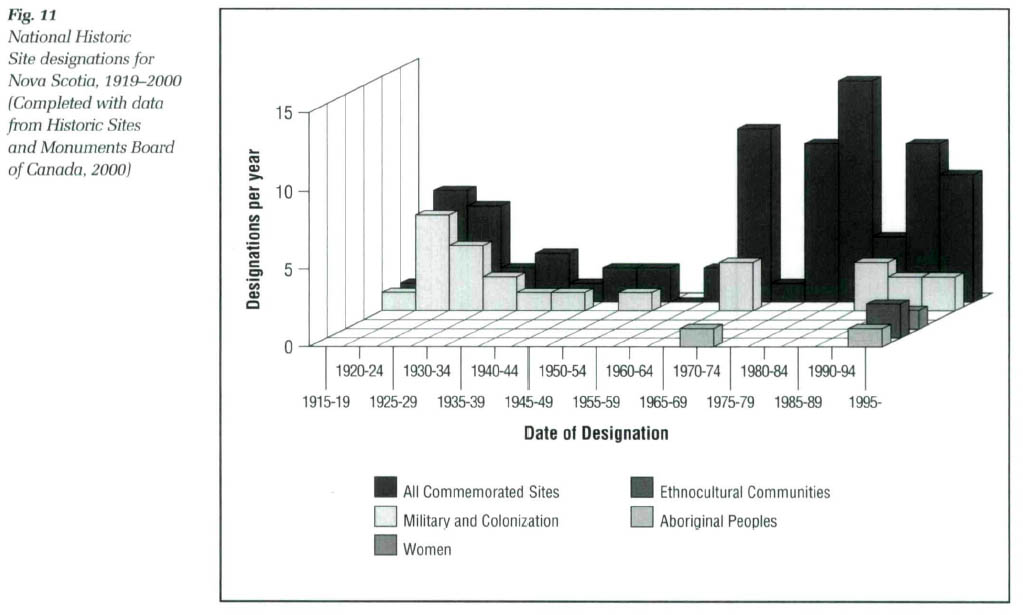 Display large image of Figure 11
Display large image of Figure 11Conclusion
42 The reburial of the bones from the Little Dutch church marked the end of the archaeological project and of the major portion of the forensic examinations63 While it created a sense of closure for those involved, it also began to raise a number of new questions about the place. In particular, those involved in the archaeological project were left pondering the implications of both the forensic and historical analysis and what they meant for present identities with and exclusive claims to place. The reburial helped to affirm known German associations with the place. On the other hand, in the burning of sweetgrass and the ritual purification of skull E66a, it also seemed to reclaim an aboriginal North American connection to this plot of land. More specifically, it established a Mi'kmaq claim to this one individual. In the past year, the results of the forensic analysis have also begun to support an Afro-Nova Scotian claim to a portion of the history of the church site. How such connections will play themselves out, only time will tell. Nevertheless, the findings have raised the prospect of contestation and of other claims, no matter how tenuous, to the place.
43 The process of discovery, analysis, and reburial high lighted the social and political potency of human remains and the role that ceremony played in, what might be called, the "materialization" of the past.64 "To re-bury a dead person," notes Verdery, "is not simply to re-assess his place in history."65 Rather, it is an opportunity for people to re-orient their relationship with the past, to redeem past injustices, and to re-invent or "re-imagine" their community or nation. But which community and which nation? "Who are our true ancestors?" Verdery asks, "Who has been unjustly shunted aside, and who has usurped their place in our lineal self-definition?... about what set of people will our national history be rewritten? Which ancestors will our history acknowledge, which forget?"66
44 Jan Assman suggests that, "through its cultural heritage a society becomes visible to itself and to others. Which past becomes evident in that heritage, and which values emerge in its identificatory appropriation, tells us much about the constitution and tendencies of a society."67 In this light, the absence of a voice for local First Nations and Afro-Nova Scotians in the plaque unveiling at the Little Dutch Church in 1999 was telling. How then do we interpret the Little Dutch Church as a "national" monument? While we may view the commemoration of sites such as the Little Dutch Church as significant in qualifying past "Anglo-French," national, meta-narratives, they still fail to fully acknowledge the multiple voices and corresponding silences that resonate in all sites. Furthermore, multiple layers of meaning are often present, as is evident in the additional claims to the heritage of the site. For Canadians of German extraction. the Little Dutch Church is an important symbol of identity. However, far from a continued association with the descendants of the earliest settlers, it may be argued that the place has a greater symbolic appeal for newer German immigrants. For them, "the building represents an important part of the cultural history of the German community;" a piece of German history in a foreign land.68 Ironically, the Little Dutch Church remains a cultural mnemonic in an area of Halifax where the "Deutsche" presence has all but vanished and where it must now be understood amidst myriad geographies.
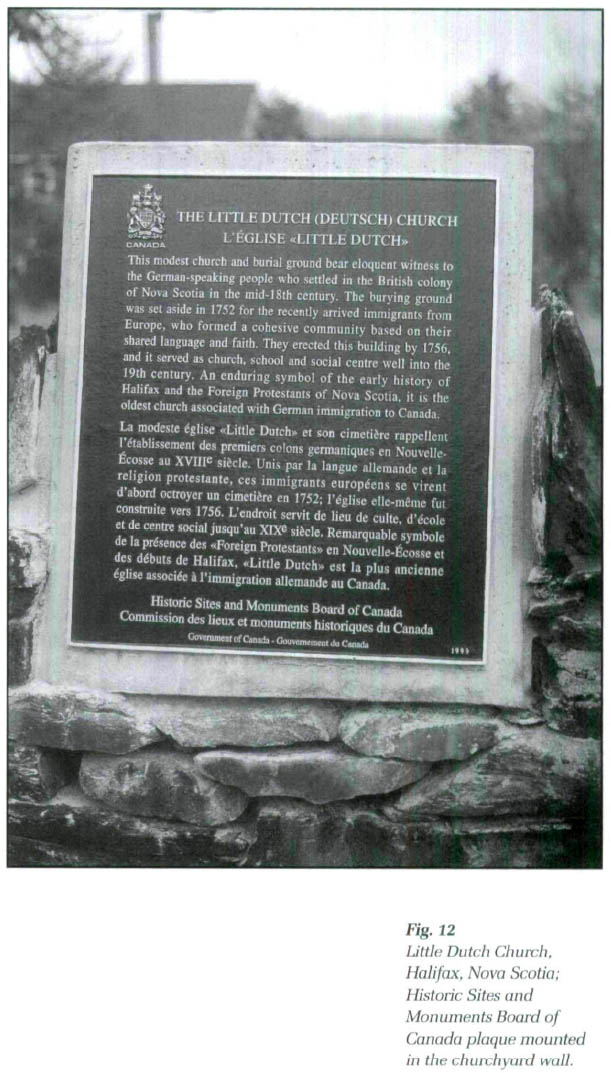 Display large image of Figure 12
Display large image of Figure 1245 Construction of place/identity is an ongoing and dynamic process. Static interpretations must be viewed in juxtaposition (or perhaps even contraposition) with a range of discourses through which place/identity comes to be understood in the course of its history, and through which it continues to acquire and generate meaning in the present. Through the histories and stories of place, through institutional and cultural structures, official endorsement, and the material remains of the past, we locate ourselves and imagine "identificatory" links to the past. But those links are, occasionally, tenuous. Identity formation is contested, as divergent memories and heritages the for recognition, and, at times, pre-eminence in particular places.
46 With the discovery of E66a and the other epidemic victims of 1750-1, we may address some of the complexities of Halifax society, even at an early date, and assess the ramifications of such findings in light of the multicultural nature of Halifax and Canada today. The discoveries have raised the spectre of early slavery in Halifax, of the complicated relationship between the settlers and the indigenous population, and of the hardship and grief faced by many. The bones of the dead now raise the question, what does the Little Dutch Church mean for the Afro-Nova-Scotian, Mi'kmaq, and, descendant German communities?
This paper is part of ongoing doctoral research in the Department of Geography at Queen's University, Kingston, Ontario. It is a continuation of work begun while the author was a part-time member of faculty in the Department of Anthropology at Saint Mary's University, Halifax, Nova Scotia. The author would like to acknowledge the contributions of his colleagues to the project: Laird Niven, co-director; Dr Paul Erickson, SMU; Dr Don Cunningham, School of Dentistry, Dalhousie University; and Dr Steve Davis, SMU. Thanks must also go to Nicole Lundrigan and April Mitchell, and all the students of Saint Mary's who participated in the project; the Rev. Gary Thorne, Rector of Saint George's; members of the Little Dutch Church Management Committee; Terry Punch; and, the German Canadian Association of Nova Scotia. Finally, especial thanks must go to Maureen Williams and to Professor Brian Osborne for their helpful comments and insights through several revisions of this paper.
